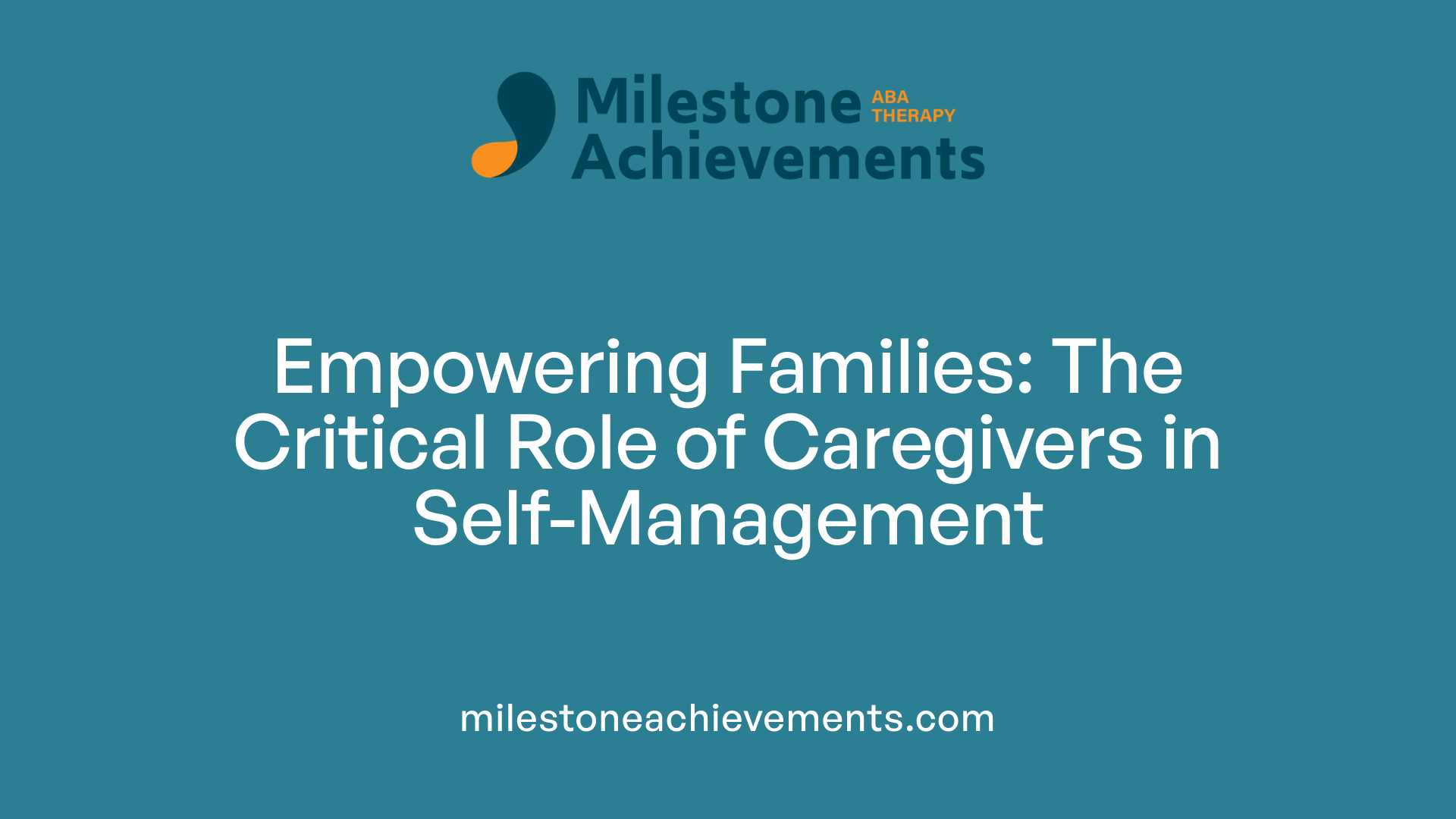
How ABA Therapy Helps Children Develop Self-Management Skills
Empowering Autistic Children Through Strategic Behavioral Interventions
Understanding the Role of ABA in Developing Self-Management Skills
Applied Behavior Analysis (ABA) is a scientifically validated approach widely recognized for its effectiveness in supporting children with autism. Among its numerous benefits, ABA specifically targets the development of self-management skills, which are essential for fostering independence, enhancing daily functioning, and improving overall quality of life. This article explores how ABA therapy promotes self-regulation, the techniques employed, and the long-term benefits for children on the autism spectrum.
Foundations of Self-Management in ABA Therapy

What components are involved in self-management within ABA?
Self-management in applied behavior analysis (ABA) encompasses several strategic components designed to foster independence and accountability. These include goal setting, where individuals identify specific targets for behavior change; self-evaluation, which involves assessing one's own behavior against predetermined standards; self-monitoring, a process of tracking behaviors regularly through tools like checklists or digital apps; and self-reinforcement, where individuals reward themselves for successful behavior execution. Additionally, self-instruction involves teaching children to use verbal or visual cues to guide their actions, while strategy instruction helps them learn how to apply specific techniques effectively. These elements work together to help individuals recognize behaviors, evaluate their performance, and implement strategies that support goal achievement.
What evidence supports the benefits of self-management strategies for individuals with developmental disabilities?
Over the past five decades, research has consistently demonstrated that self-management strategies are highly effective for individuals with developmental and intellectual disabilities. Scientific studies reveal that these approaches significantly improve adaptive skills, including social communication, daily living, academic performance, and the ability to stay focused and on-task. Furthermore, evidence indicates that self-management interventions reduce problematic behaviors such as inappropriate vocalizations, self-stimulatory actions, aggression, tantrums, and self-injury. Major research councils and behavior analysts have reviewed these strategies as evidence-based practices, validating their effectiveness across different age groups and settings. The consistent positive outcomes support the integration of self-management approaches into comprehensive ABA programs.
How does self-management contribute to adaptive skills like social communication, daily living, and academic performance?
Self-management strategies play a crucial role in helping individuals develop skills that are essential for independence. By learning to set personal goals, monitor their behaviors, and use reinforcement, children can improve their social interactions, such as sharing, taking turns, and interpreting social cues. They also gain competence in daily routines—like dressing, grooming, preparing meals, and managing money—by breaking tasks into smaller, manageable steps using task analysis. In academic settings, self-management enables students to focus, complete assignments, and develop organizational skills. The consistent practice of these strategies fosters not only skill acquisition but also self-confidence and motivation, which are vital for lifelong independence. As individuals become more capable of regulating their own behaviors, they are better equipped to navigate social, personal, and educational challenges effectively.
Techniques and Strategies Used in ABA to Foster Self-Management

What techniques and strategies does ABA therapy use to support self-management development?
Applied Behavior Analysis (ABA) employs a comprehensive set of techniques to build self-management skills. These strategies are grounded in behavioral science and tailored to individual needs, enabling children and adults on the autism spectrum or with developmental challenges to gain independence.
One of the foundational methods is reinforcement. Positive feedback or tangible rewards are provided when individuals demonstrate desired behaviors, which increases the likelihood of those behaviors recurring. Reinforcement helps motivate learning and sustain progress over time.
Self-monitoring and self-evaluation are also vital components of ABA. Individuals are taught to observe their own behaviors, record occurrences, and compare performance against predefined standards. This fosters greater self-awareness and accountability, encouraging the learner to self-correct and make adjustments.
Goal setting involves establishing clear, achievable targets tailored to individual needs, guiding the learning process and providing measurable benchmarks for success. Coupled with goal tracking, these help individuals understand their progress and stay motivated.
Prompt fading—gradually reducing verbal cues, physical guidance, or visual aids—is used to promote independence. Initially, prompts assist the learner in performing tasks; as competence develops, prompts are systematically withdrawn.
Task analysis breaks down complex skills into smaller, manageable steps. This approach ensures mastery of each component before progressing, facilitating more effective learning of challenging behaviors such as self-care, communication, and social skills.
These core strategies are often complemented by visual aids, social stories, and self-instructional tools. Visual schedules, picture cards, and checklists help clarify expectations and routines, reducing anxiety and enhancing executive functioning.
Social stories illustrate appropriate behaviors in specific situations, promoting understanding and social competence. Self-instructional tools, including cue cards and personal scripts, guide individuals through steps and problem-solving processes, fostering autonomy.
Modeling and role-playing are dynamic techniques used in ABA to teach new skills. By observing and mimicking others, learners practice behaviors within safe, controlled environments. These methods increase proficiency and confidence.
Environmental modifications—such as arranging the physical space, reducing distractions, or establishing consistent routines—support generalization and enhance the effectiveness of self-management strategies.
In summary, ABA integrates these targeted techniques—reinforcement, self-monitoring, goal-setting, prompt fading, task analysis, visual supports, modeling, and environmental adjustments—to develop robust self-management skills. The ultimate goal is to empower individuals to regulate their own behaviors, solve problems independently, and navigate diverse settings with confidence.
Implementing Self-Management Strategies Effectively

How does ABA therapy help children develop self-management skills?
ABA therapy is instrumental in helping children, especially those on the autism spectrum, develop vital self-management skills. It teaches them to set personal goals, monitor their own behaviors, and apply strategies like self-instruction and self-reinforcement to regulate their actions.
Through structured interventions, ABA incorporates visual aids, routines, and behavioral logs that foster independence and accountability. These tools empower children to recognize triggers, initiate appropriate responses, and evaluate their progress.
ABA strategies also focus on teaching emotional regulation, task initiation, and time management—skills essential for everyday life. This approach ensures that children can generalize these skills across multiple settings such as home, school, and community, promoting consistency.
An important aspect is gradually reducing external prompts, which encourages children to rely on internal cues and self-guidance. This nurtures autonomy and decision-making capacity, ultimately helping them become more responsible for their behaviors.
Research-backed and evidence-based, ABA offers a comprehensive suite of tools designed to foster self-awareness, self-control, and resilience. These skills are crucial for long-term success in daily activities, social engagement, and personal development.
The Effectiveness of ABA in Enhancing Self-Management Skills
How effective is ABA therapy in enhancing self-management abilities in children with ASD?
Research consistently demonstrates that Applied Behavior Analysis (ABA) therapy is highly effective in improving self-management skills among children with Autism Spectrum Disorder (ASD). ABA employs a variety of evidence-based strategies such as goal setting, self-monitoring, self-evaluation, self-reinforcement, and self-instruction. These techniques help children recognize behavioral patterns, monitor their actions, and take active steps towards achieving personal goals.
Through structured programs, children are taught to break down complex skills like social interaction, daily routines, and academic tasks into smaller, manageable steps using task analysis. Reinforcement—either through praise or tangible rewards—motivates children, making the learning process engaging and effective. Prompting methods, including verbal cues, visual aids, or physical guidance, support children in completing tasks, with gradually faded prompts encouraging independence.
The personalized nature of ABA allows programs to address individual needs and abilities effectively. This tailored approach, combined with consistent practice and reinforcement, results in meaningful improvements in self-regulation, social-communication, and daily-living skills.
Crucially, ABA’s emphasis on teaching skills in varied environments promotes the generalization of behaviors across settings such as home, school, and community. This adaptability ensures that children can apply learned skills in real-world contexts, thereby enhancing their independence.
What are the long-term benefits of using ABA for self-management?
Long-term benefits of ABA-focused self-management interventions extend beyond immediate skill acquisition. Children develop greater independence in daily activities like personal hygiene, dressing, preparing meals, managing money, and navigating social situations. These abilities not only improve their quality of life but also reduce reliance on caregivers, fostering a sense of autonomy.
In addition, ABA interventions contribute to better academic performance by developing organizational skills, attention, and task completion. As children gain self-regulation capabilities, they are better equipped to handle transitions, cope with challenges, and manage emotional responses.
Moreover, reducing problem behaviors such as aggression, tantrums, self-injury, and stereotypy results in safer, calmer environments both at home and in educational settings. These behavioral improvements can diminish the need for intensive oversight over time and lower healthcare costs.
Researchers highlight that developing self-management skills builds resilience, decision-making, and critical thinking—critical tools for navigating adulthood successfully. By teaching children to analyze situations and select appropriate responses, ABA programs prepare them for independent living and successful integration into society.
What is the role of caregiver involvement in the success of self-management strategies?
Caregiver involvement is essential for maximizing the success of self-management strategies in ABA therapy. Families actively participating in reinforcement and practicing strategies like visual schedules or self-monitoring tools create consistent, supportive environments that reinforce learning.
Caregivers can help by applying techniques at home, encouraging routine use of visual aids, and providing positive feedback. This consistency enhances skill retention and generalization across different settings. Additionally, caregiver training empowers families to implement strategies effectively, fostering a collaborative approach to intervention.
The use of modeling and role-playing by caregivers reinforces skills taught during therapy sessions. Their participation helps children practice and imitate positive behaviors, strengthening social and emotional skills.
Research indicates that empowering families yields high social validity and enhances overall outcomes. When caregivers are involved, children tend to show greater motivation, confidence, and independence.
In conclusion, the integration of active caregiver participation, evidence-based techniques, and supportive environments makes ABA a comprehensive and effective approach to fostering self-management skills in children with ASD. This collaborative effort ensures sustained behavioral improvements, optimal generalization, and a foundation for lifelong independence.
| Aspect | Details | Additional Notes |
|---|---|---|
| Strategies Used | Goal setting, self-monitoring, reinforcement, prompting | Customized to individual needs |
| Settings | Home, school, community | Supports generalization |
| Long-term Outcomes | Independence, reduced problem behaviors, academic and social skills | Builds resilience and autonomy |
| Caregiver Role | Reinforcement, modeling, consistent practice | Critical for success |
| Overall Effectiveness | High | Supported by extensive research |
This collective approach underscores the importance of structured, evidence-based interventions in shaping positive, lasting change for children with ASD, promoting their journey toward independence and active engagement in daily life.
The Role of Caregivers and Family in Strengthening Self-Management Skills

How can training families to reinforce learned skills at home benefit children with autism?
Family involvement is vital in ensuring the success of self-management strategies learned through ABA therapy. When families are trained to reinforce skills at home, they help translate what children learn in therapy sessions into real-life situations. This reinforcement enhances consistency, which is crucial for skill acquisition and maintenance. Family members can use specific techniques such as providing positive feedback, utilizing visual aids, and following structured routines to support the child's learning.
Research indicates that active caregiver participation increases motivation in children and promotes better generalization of skills across different environments. When families understand their role in reinforcing behaviors—such as self-care routines, communication efforts, or academic tasks—they contribute significantly to the child's progress and independence.
How can creating consistent routines and routine reinforcement support self-management?
Establishing predictable routines helps children with autism anticipate daily activities, reducing anxiety and promoting independence. Consistent routines provide a structure that supports self-management skills like self-instruction and self-monitoring.
Reinforcing routines regularly—using visual schedules or checklists—increases a child’s understanding and adherence to expected behaviors. For example, a visual schedule for morning tasks such as brushing teeth, dressing, and packing school supplies guides children through daily activities and encourages them to become more autonomous. Routine reinforcement also involves calmly reminding children of steps if they forget or need cues, fostering resilience and memory.
By integrating routine reinforcement within the home, children learn to manage tasks independently while caregivers help them practice these skills in varying contexts, strengthening their ability to generalize across settings.
What role do visual schedules and self-monitoring tools play at home?
Visual schedules are powerful tools that help children understand what they are expected to do throughout the day. They visually break down tasks into manageable steps, using pictures or symbols that children can easily interpret. Implementing visual schedules at home supports self-paced learning and self-regulation, allowing children to navigate their daily routines with less frustration.
Self-monitoring tools, such as checklists or digital apps, enable children to track their own behaviors and progress toward goals. When children use these tools, they develop self-awareness and accountability, which are crucial components of self-management.
For example, a child might check off tasks like
Promoting Emotional Regulation and Decision-Making Skills
How does ABA therapy help children develop self-management skills?
ABA therapy plays a vital role in helping children with autism develop effective self-management skills. It teaches children to set realistic goals, monitor their behaviors, and use self-instruction strategies to guide their actions. Through structured interventions, children learn to identify triggers and adopt appropriate responses.
In practice, ABA utilizes visual supports like schedules and charts, routines that build consistency, and behavioral logs to track progress. These tools promote independence by encouraging children to take responsibility for their behaviors. Self-management training often includes teaching emotional regulation, initiating tasks, managing time, and responding socially in appropriate ways.
One of the strengths of ABA is its focus on gradually reducing external prompts—children learn to rely on internal cues and strategies. Over time, they become more autonomous, making decisions and managing emotions without constant supervision. This empowerment enhances their ability to function independently across various settings, including home, school, and community.
By fostering self-awareness, self-control, and accountability, ABA equips children with lifelong skills. These skills are essential for navigating social situations, handling challenges, and participating fully in daily life. The evidence-based techniques embedded in ABA methods underpin these improvements, providing a foundation for sustained personal growth and independence.
Teaching coping strategies like deep breathing and visual supports
An essential component of emotional regulation involves teaching children coping strategies such as deep breathing exercises and the use of visual supports. Deep breathing helps calm the nervous system during moments of stress or anxiety, giving children a tool to regain control over intense emotions.
Visual supports—like picture sequences or charts—serve as external reminders for children to practice these techniques consistently. Visual cues can outline steps for calming down, help children recognize emotional states, and prompt the use of coping strategies when needed.
In ABA programs, these supports are tailored to each child's needs, ensuring they understand and can apply calming techniques independently. Practice in various settings, such as at home or school, reinforces their use and promotes emotional stability.
Encouraging decision-making, problem-solving, and resilience
Building decision-making and problem-solving skills is critical for developing resilience, which enables children to bounce back from setbacks. ABA therapy incorporates activities that challenge children to make choices, weigh options, and understand consequences.
Through role-playing, social stories, and real-life scenarios, children learn to analyze situations, think critically, and respond adaptively. Celebrating successes, even small ones, boosts confidence and perseverance.
Resilience is further fostered by teaching children to cope with frustration and disappointment constructively. Strategies like deep breathing, positive self-talk, and visual aids help children manage difficult emotions and maintain focus on solutions.
The importance of developing emotional self-awareness
An often-overlooked element of self-management is emotional self-awareness—the ability to recognize and understand one's feelings. Teaching children to label their emotions enables them to communicate needs effectively and choose appropriate responses.
ABA interventions include activities such as emotion recognition games, labeling exercises, and using facial expression charts. These tools help children build a vocabulary for their feelings and develop insight into their emotional states.
Promoting emotional self-awareness supports better regulation, enhances social interactions, and reduces behavioral outbursts. When children understand what they are feeling, they can implement calming strategies proactively, leading to more positive experiences and relationships.
Practical techniques and tools for fostering self-management skills
| Technique/Tool | Description | Benefits |
|---|---|---|
| Visual Schedules | Daily routines broken into pictures | Reduces anxiety, increases predictability |
| Goal Setting | Small, achievable objectives | Builds motivation, focuses efforts |
| Behavioral Contracts | Agreements outlining expected behaviors | Clarifies expectations, enhances accountability |
| Self-Monitoring Tools | Checklists, digital apps | Increases self-awareness, promotes responsibility |
| Reinforcement Systems | Praise, rewards | Motivates ongoing use of strategies |
Creating a supportive environment with routines, clear communication, and consistent reinforcement fosters the development of these emotional regulation and decision-making skills. Active caregiver involvement ensures that strategies are reinforced at home and in community settings, amplifying their effectiveness.
Long-term impacts and ongoing development
Developing these skills has lasting effects, including improved daily functioning, greater independence, and enhanced social skills. It also helps reduce anxiety and behavioral challenges, making daily interactions smoother.
Children equipped with emotional regulation and decision-making skills are better prepared for future challenges, including school transitions and social relationships. They are more resilient and capable of handling complexities in various aspects of life.
Overall, integrating self-management strategies into ABA not only addresses immediate behavioral concerns but also fosters essential life skills that support lifelong growth and self-control.
Long-Term Impact and Lifelong Skill Development

What are the lifelong benefits of developing self-management skills?
Building self-management skills provides children and adults with developmental and intellectual disabilities with essential tools for personal independence. These skills enable individuals to handle challenges on their own, transition smoothly between tasks, and participate actively in various aspects of life. For example, they can manage daily routines such as personal hygiene, prepare simple meals, or use money effectively, fostering greater autonomy.
Moreover, self-management promotes emotional resilience by helping individuals recognize and regulate their feelings, thereby reducing anxiety and stress. These skills improve adaptability when facing new or unexpected situations, which is critical for success in diverse environments including school, work, and social settings.
Research over the past decades confirms that the development of self-management strategies leads to improvements in social interactions, academic performance, and daily activities. These benefits are observed throughout the lifespan, showing that early skill development supports ongoing independence and quality of life.
What strategies help maintain skills over time?
Maintaining self-management skills requires consistent reinforcement and practice across different contexts. Using visual supports, such as schedules or checklists, helps reinforce routines and expectations, making routines predictable and less stressful.
Incorporating ongoing practice routines, like periodic reviews or booster sessions, ensures that skills remain fresh and applicable. Technology, such as digital apps or timers, can support self-monitoring and self-recording, increasing accountability.
Training caregivers and educators to provide continuous reinforcement and feedback is also essential. Active participation from family members ensures that skills are practiced at home and in community settings, facilitating their retention and generalization.
How can skills be transitioned into adult environments?
Transitioning self-management skills into adulthood involves gradually increasing the complexity and independence of tasks. This process often begins with identifying relevant skills for independent living, employment, or community engagement.
Adapting personalized plans that incorporate real-life scenarios prepares individuals for specific challenges they may face outside structured therapy settings. For example, teaching money management skills through real transactions or public transportation navigation through supervised outings.
Educational programs and vocational training often include modules on self-regulation and decision-making to foster autonomy. Encouraging decision-making, problem-solving, and self-advocacy empowers adults to handle their routines confidently.
Finally, ongoing support and coaching from professionals, friends, and family help individuals troubleshoot obstacles and reinforce mature self-management strategies. As skills become more ingrained, reliance on external prompts decreases, paving the way for individuals to lead independent, fulfilling lives.
| Aspect | Strategies | Additional Notes |
|---|---|---|
| Lifelong benefits | Developing independence, reducing anxiety, improving social and academic skills | Supports better quality of life and societal participation |
| Maintaining skills | Consistent practice, visual supports, technology aids, caregiver involvement | Ensures skills are retained and adaptable |
| Transition into adult settings | Real-world practice, personalized planning, ongoing support | Fosters independence in adult roles and environments |
The Transformative Power of Behavioral Interventions
ABA therapy stands out as a comprehensive and effective approach to improving self-management skills in children with autism. By teaching goal setting, self-monitoring, reinforcement, and emotional regulation, ABA equips children with the tools necessary for independence across multiple life domains. The active involvement of families and tailored interventions ensures that these skills generalize well beyond therapy sessions, ultimately fostering resilience, confidence, and lifelong success. As research continues to validate its effectiveness, ABA remains a cornerstone in supporting children on the autism spectrum toward more autonomous, fulfilling lives.
References
- Self-management skills and applied behavior analysis.
- How ABA therapy can help children with autism develop ...
- 7 Surprising Benefits of ABA Therapy for Kids You Need to Know
- (PDF) Self-Management Skills and Applied Behavior Analysis
- Developing Self-Management Skills Through ABA: Building Lifelong ...
- 7 Essential Self Management Strategies for ABA Therapy Success
- Applied Behavior Analysis (ABA) | Autism Speaks
- ABA Therapy: Promoting Independence in Daily Life


Partner with us on your child's journey
Milestone Achievements offers evidence-based ABA therapy to help children with autism reach their full potential. Together we’ll set meaningful goals and celebrate progress every step of the way.
Start ABA Services Today


